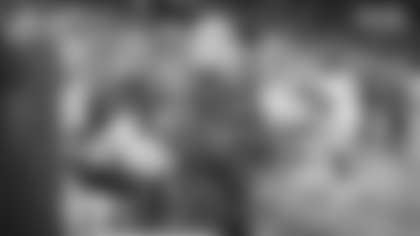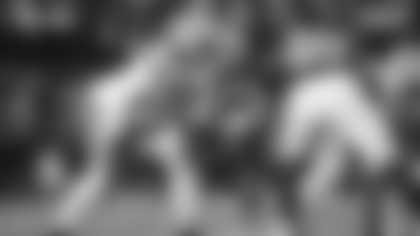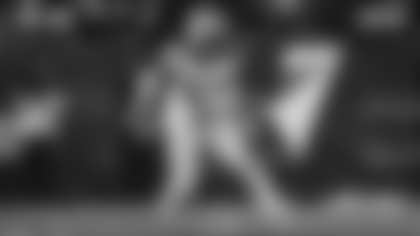The Packers' tribute to George Calhoun and the website's Pet of the Week feature made my wife (the daughter of longtime trainer Carl "Bud" Jorgensen) recall a personal side of George. He used to send out Christmas cards with a picture of him and his dog. Could you elaborate on George's card sending habits and share anything else that would give us a glimpse of the personal side of this special man? - Tom, Stevens Point, Wis.
Tom, whether inadvertently or by design, you have identified one of the most colorful and memorable characters in the Packers' long history. And, with respect to your question, George Whitney Calhoun, the man who joined Curly Lambeau in calling the very first meeting of the fledgling Packers in August of 1919, did make it an annual custom to send out Christmas cards featuring the current and updated picture of his beloved bulldog.
Each year, the card's cover photo of Calhoun's canine would be entitled something like this: "Patsy Twosie Tiger in her (fill in the blank) season."
Calhoun, then the Packers' part-time publicity director while simultaneously serving as a full-time member of the Green Bay Press-Gazette editorial staffs, was a bachelor and "Patsy" accompanied him everywhere, even to Sham O'Brien's pub, Calhoun's favorite watering hole on the city's north side, where Patsy had a privileged position at the bar -- always with her own bowl of beer.
I used to occupy the desk next to Calhoun in the editorial department of the Press-Gazette, where he then was serving as assistant telegraph editor, and thus got to know his habits and idiosyncrasies pretty well. To the best of my recollection, the last such card I remember receiving was when Patsy Twosie was in her eleventh season.
"Cal,' as he was known to all who knew him, invariably presented a crusty, sometimes profane exterior (except when women were in his area) but underneath it all, he was a soft-spoken sentimentalist who was fiercely loyal to his friends.
Lee, I'm 90 percent certain that I saw Paul Hornung free kick a field goal from 52 yards out just before halftime at Lambeau Field. A friend tells me that the play took place in Milwaukee. Can you provide any details, such as the year, the site and the team the Packers were playing? Thanks. - Jim, Sheboygan, Wis.
Jim, you did see what you thought you saw. Hornung did kick a 52-yard "free kick" field goal in Lambeau Field in the final minute of the first half of the Packers' 23-12
victory over the Chicago Bears in their mutual season opener on September 13, 1964.
Elsewhere in this column, there is a note suggesting that the kick was a dropkick. For the record, emphatically, it was not...it was a kick from placement.
Of all the rivalries in the NFL, Green Bay and Chicago is the oldest. What are some of the other historic rivalries from across the NFL. And where does Green Bay and Detroit fit in? - Kevin, River Falls, Wis.
Technically speaking, the Chicago Bears' rivalry with the Arizona Cardinals is the National Football League's oldest. It began in 1920, the year the NFL was founded under the name of the American Professional Football Conference (a name that was changed to the American Professional Football Association before the initial season was far advanced).
From the frequency perspective, however, the Packers (who entered the NFL in 1921) and Bears have met much more often. They have faced each other 170 times -- more often than any other two teams in league history.
Meanwhile, the Bears and Cardinals have met on only 86 occasions, the Bears holding a 54-26-6 advantage.
With respect to Detroit, the Lions did not enter the NFL until 1934. The franchise originated in Portsmouth, Ohio in 1930 and the team originally was known as the Spartans, moving to Detroit in '34.
However, the Lions -- in company with the Bears -- are the possessors of the second-most contested rivalry in NFL annals. They have played each other 152 times, a total which ranks behind only the Packers-Bears' 170 confrontations.
Next up in terms of frequency: The Packers' 151 meetings with Detroit, followed by the New York Giants' 146-game rivalry with the Washington Redskins and the Giants' 142-game series with the Philadelphia Eagles.
Paul Hornung is by far the most celebrated of Green Bay running backs, but how would you compare him to Ahman Green or the new kid on the block, Samkon Gado? - Tim, San Diego, Calif.
Tim, I think it would be difficult to make a fair comparison of Paul Hornung to Ahman Green or Samkon Gado, primarily because Hornung was an all-purpose running back who was called upon to do more things than either Green or Gado. One essential difference: both Green and Gado are blessed with much greater speed than Hornung, which is another way of saying the game's emphasis has changed in the intervening 50 years.
Be that as it may, Hornung justly ranks among the most versatile running backs in NFL history. He was a highly effective runner, an excellent receiver, an outstanding blocker and an accomplished kicker, who holds the league's single season scoring record (176 points in 1960), one of the most remarkable records in all of sports.
Hi Lee! I was wondering if you and your fellow scribes had any special kind of approach when it came time to interviewing Vince Lombardi. I read in a recent Lombardi biography as to how challenging this actually was and would very much appreciate your recollections on this topic. Thank you very much!! - Marin, West Lawn, Pa.
Quite frankly, interviewing Vince Lombardi during the season, or the post-season for that matter, was a little like a visit to the dentist. Apparently concerned that something he said might be misinterpreted by the media and appear on an opponent's locker room blackboard and thus be used against him or his team, he was typically from brusque to rude in his replies. He was known to often respond to a routine question by shouting, "What the hell kind of a question was that!" And he generally ignored the query. His belligerent reply invariably served to intimidate the luckless questioner.
Contrarily, in the off-season, I personally found Lombardi a great interview when I had an annual visit with him on assignment for the "Packers Yearbook." On those occasions, though there were no games or championships to be concerned about, he still was "all business" and my questions had to be prepared and succinct. But a man with a gift for turning a classic phrase ("the harder a man works, the harder it is to surrender") he gave me eloquent and extensive answers to all questions -- and I always came away feeling I had achieved my professional objective. If I did or did not is for others to judge.
I was reading Arnie Herber's Hall of Fame bio and it was noted that no official records were kept before 1932. Did the Packers keep and do they still have any "unofficial" records from that time? - Joe, Ft. Worth, Texas
Unfortunately, Joe, we have no records (official or unofficial) of Arnie Herber's exploits prior to 1932. Record-keeping, with respect to individual statistics, did not come into vogue until somewhat later -- probably around 1940.
It does appear to be clear from the observations of those who saw him play, however, that Herber was one of the premier passers of his early day, along with Benny Friedman of Michigan and the New York Giants.
Herber also was the throwing half of the first great passing combination in NFL history -- "Herber to Hutson" -- a duo that victimized opposing defenses in the latter half of the 1930s and played a significant role in popularizing professional football.
Ironically, after he left the Packers following the 1940 season, Herber was to face his old team in the 1944 NFL championship game as a member of the New York Giants. Earlier in the '44 season, Herber had presided over a 24-0 Giants victory over Green Bay, but the Packers subsequently had the better of the argument in the '44 title game, prevailing 14-7 to annex their sixth world crown.
Dear Mr.Remmel, after Doug Flutie's drop kick against Miami last January, the press reported that it was the first drop kick in the NFL since 1941. However, if memory serves, Paul Hornung's winning "free kick" field goal against Chicago in 1964 was a drop kick. Is that right? Regards - Jim, Indianapolis, Ind.
Jim, I am sorry to report that your memory of Paul Hornung's 1964 free kick field goal was slightly off target. It, for the record, was not a dropkick. It was a kick from placement -- a 52-yarder that, at the time, tied the Packers' field goal distance record held by Ted Fritsch.
Under the rule, it should be added, the defense was not allowed to rush or attempt to block the kick. The rule remains unchanged.
The kick was delivered in Lambeeau Field, not Milwaukee, as you remembered it.
I am not sure when the Packers last attempted a drop kick in a game, but it had to have been years earlier than 1964.
Lee, did the movie actor Earnest Borgnine ever play coach Lombardi back in the 1970's? If so, what was the name of the movie and how can I rent or purchase it? Regards - Ken, Easton, Pa
Yes, Earnest Borgnine indeed did play the role of Vince Lombardi in what I recall as a made-for-television film. My recollection is that it was made in the '70s and was presented by the ABC Network, with the title of "A Man Named Lombardi."
Colleen Dewhusrt played the role of Marie Lombardi, Vince's spouse, and an actor named James Olson, clearly miscast in the role, played the part of Paul Hornung.
Mr. Remmel, football fans have been enjoying Monday Night Football on ABC since 1970. I recently acquired an old ticket to a Packers-Cardinals game in St. Louis, held on Monday night, Oct. 30, 1967, during Lombardi's final season as Packers head coach. What can you tell me about this early Packers Monday night appearance? Do you know if this was a televised game and were they using it as a test to see if there would be a Monday night audience interested in watching pro football? - Tim, Watertown
Tim, the game you mentioned, on October 30, 1967, was nationally televised by CBS (three years before ABC founded a national institution called "Monday Night Football").
That '67 contest is historically memorable because it marked the explosive debut of the late Travis Williams as the Packers' kickoff returner, who launched the greatest such season in NFL annals.
Willliams, a rookie employed in that role for the first time, made a dramatic "bow" early in the fourth quarter. With the Packers in arrears, 23-17, Williams returned a Jim Bakken kickoff 93 yards for a touchdown to tie the score. Don Chandler's subsequent conversion eventually settled the issue, although the Packers scored again to depart St. Louis with a 31-23 victory.
From that day forward, Williams was en route to the NFL record book, returning three more kickoffs for touchdowns (one for 104 yards) and closing out the season with what remains a league record, a 41.06-yard average on 18 returns.
Hi Lee. I was hoping that you could shed some light on a friendly debate I am having with a friend. I believe that the Packers chose Paul Hornung in the draft when they could have selected Jim Brown. We are debating who would have been the best for the Packers. Even though Brown was almost undoubtedly the best running back (or player) in history, I think he would have clashed with Lombardi because of his ego and his unwillingness to block. My question is, do you think Jim Brown would have made the Packers a stronger team than Hornung? Thanks - Pat, Drain, Ore.
Pat, I am inclined to "vote" for Hornung on this one, because of his remarkable versatility. He could -- and did, as I mentioned in my answer to an earlier question about No. 5 -- contribute to a host of Packers victories in the golden '60s as a runner, blocker, receiver and placekicker. En route, he led the NFL in scoring three years in a row (1959-60-'61), amassing a record 176 points in 12 games in '60, a record that still stands nearly a half-century later.
Always supremely confident, Hornung also was an inspirational leader, a quality which prompted Vince Lombardi to observe, "At midfield, Paul Hornung was an ordinary halfback, but inside the 20, he was the greatest I have ever seen."
Brown, admittedly, was the better runner but he was essentially a one-dimensional player. He contributed little else to the Browns' cause over his nine seasons.
Lee, your bio at the end of your column says that you have been associated with the Packers for 55 years. That's a lot of Packer games! What is the first game you remember seeing, and did the Packers win? - Donovan, Torrington, Conn.
Donovan, the first Packers game I ever saw was on September 24, 1944, at "old" City Stadium, located just a stone's throw from Green Bay's East River. Appropriately, it was against the Packers' already longtime rivals, the Chicago Bears.
The Packers charged to a 28-0 lead in what appeared to be a budding rout, but the Bears stormed back to tie the score at 28-all, forcing the Packers to mount a two-touchdown comeback in the fourth quarter -- on an end sweep by halfback Lou Brock down the east sidelines for the go-ahead score and a subsequent 55-yard runback of an interception
by fullback/linebacker Ted Fritsch for the day's final touchdown.
Lee, what was the reason that games were held in Milwaukee? How did they come to be and what is the background? - Chris, Aurora, Colo.
Simple economic necessity prompted the Packers' decision to play a portion of their regular season home schedule at Milwaukee. They were drawing modest crowds in the 3,000 to 5,000 range and were finding it difficult to make ends meet with those numbers.
There also was a secondary reason for playing games in Milwaukee -- to thwart any efforts to establish another pro football team there.
The Packers initiated their Milwaukee presence in 1933, playing a lone regular season game that year at Borchert Field, then the home of the original Milwaukee Brewers (then members of the Triple-A American Association). It was a winning venture by the way -- the Packers defeated the New York Giants, 20-6.
Equally important, the contest drew 12,467 fans, which turned out to be the Packers' largest "home" attendance of the season.
They went on t o play a portion of their home games (usually two or three) in Milwaukee for the next 62 years, closing out the tenure with a dramatic, last second 21-17 victory over the Atlanta Falcons at Milwaukee County Stadium, December 18, 1994, on a climactic bootleg into the right corner of the end zone by quarterback Brett Favre.
The Packers since have played all home games in Lambeau Field.
During their Milwaukeee history, they played games in four stadiums -- Borchert Field (1933), State Fair Park (1934-1951), Marquette Stadium (1952) and County Stadium (1953-94).
Click here for additional Packers stadium history.
Lee, the real unsung hero of the Lombardi era was Jack Vanisi. Can you give me some more background on this man? Also, was he by chance any relation to a Jerry Vanisi, who was GM of the Bears and Lions? - Richard, Steamboat Springs, Colo.
Answering your second and last question first, Jerry Vanisi was Jack's younger brother. There also was a third brother, Dr. Samuel Vanisi, a nationally known expert on the eye problems that can afflict animals.
But, on the subject of Jack Vanisi, he was a former Notre Dame lineman who came to Green Bay in 1950 with Gene Ronzani, then becoming the Packers vice president, head coach and general manager. (Ronzani, while playing halfback with the Bears, had become friendly with the teen-aged Vainisi because the latter's parents owned a grocery store near Chicago's Wrigley Field, and Jack used to hang around the team).
Employed in a variety of roles by the Packers as a scout and administrative aide, Vanisi was to become highly regarded as a talent scout, particularly after the 1958 NFL draft, which many consider the most productive in Packers history (it netted LB Dan Currrie, first round, fullback Jim Taylor, second round, linebacker Ray Nitschke, third round and guard Jerry Kramer, fourth round).
Unfortunately for both Jack and the Packers, his pro football career was to be brief. Having developed rheumatic fever while playing service football in Japan in the late 1940s, Vanisi died suddenly of a heart attack in late November of 1960 at the age of 33.
Continuing an association with the team that is more than 55 years old, Lee Remmel was named the first official Team Historian of the Green Bay Packers in February 2004. The former *Green Bay Press-Gazette reporter and Packers public relations director, Remmel will write regular columns for Packers.com as part of his new assignment.
In addition to those articles, Remmel will answer fan questions in a monthly Q&A column. To submit a question to Remmel, click here. *














